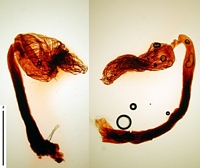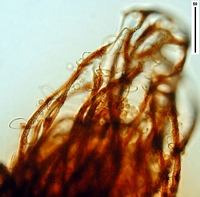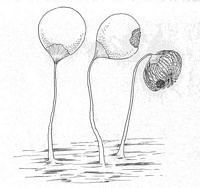|
 Cribraria cancellata Cribraria cancellata
SynonymsDictydium cancellatum
Dictydium cancellatum var. fuscum
Dictydium umbilicatum
Mucor cancellatus
Dictydium umbilicatum var. fuscum
BiostatusPresent in region - Indigenous. Non endemic
Images (click to enlarge)
Owner: J.A. Cooper | 
Caption: apex of net
Owner: J.A. Cooper | 
Caption: Sporangia of Cribraria cancellata. The one on the right shows the longitudinal ribs characteristic of the peridial net in this species. Each sporangium is about 3 mm tall.
Owner: S.L. Stephenson |
Article: Stephenson, S.L. (2003). Myxomycetes of New Zealand. Fungi of New Zealand. Ngā Harore o Aotearoa 3: xiv + 238 p. Hong Kong: Fungal Diversity Press.
Description: Fruiting body a stalked sporangium, gregarious, often occurring in extensive fruitings, 1–5 mm tall. Sporotheca globose, usually nodding, deep reddish brown or brownish purple, varying to bright purple or rufous, 0.4–0.7 mm in diameter. Stalk long, slender, striate, often twisted near the apex, dark brown to black below, one to eight times as long as the diameter of the sporotheca. Peridial net consisting of a system of rigid, longitudinal ribs connected by delicate transverse filaments, usually umbilicate above. Calyculus absent; dictydine granules yellow or light orange yellow to deep brown, densely aggregated on the ribs of the peridial net, 1–2 um in diameter. Spores brick red or reddish purple-brown in mass, nearly colourless by transmitted light, nearly smooth to minutely warted, 4–7 µm in diameter. Plasmodium purple-black.
Habitat: Decaying wood, particularly that of conifers.
Distribution: Cosmopolitan (Martin & Alexopoulos 1969) . First reported (as Dictydium umbilicatum) from New Zealand by Lister & Lister (1905), based on a specimen collected in Taranaki. Also known from Auckland, Buller, Dunedin, Southland (Rawson 1937), and Stewart Island.
Notes: In most earlier treatments of the myxomycetes, this species is placed in a separate genus (Dictydium) on the basis of the prominent longitudinal ribs of the peridial net and the lack of a calyculus. Nannenga-Bremekamp (1964) pointed out that neither feature is absolutely different for the two genera and combined Dictydium and Cribraria.
|